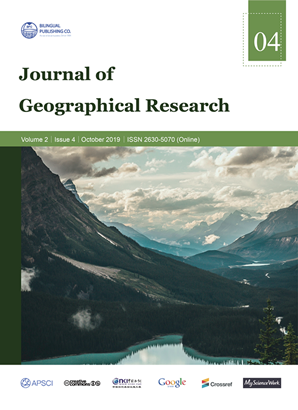-
11162
-
1915
-
1843
-
1704
-
1391
Land Conversions and Forest Dynamics in a Riparian Forest Zone in South East Nigeria
DOI:
https://doi.org/10.30564/jgr.v2i4.1449Abstract
The rate at which forest ecosystems are lost and modified across tropical landscapes are alarming, yet proper documentation and proactive mea sures to curtail this still remains a huge challenge in most areas. This research focused on elucidating the ongoing land use change patterns of a riparian forest landscape, its current impacts on the ecosystem and land surface temperature, as well as its likely future scenarios for the zone. LANDSAT images were downloaded for 1988, 2003 and 2018 and used to show the dynamics for the zone, its drivers and their varying temperatures. Maximum Likelihood Classification algorithm was used for the classification and the land-use classes were categorized as: Water body, Farms and Sparse Vegetation, Built-up Areas, Bare Surface, and Thick Vegetation. Furthermore, Markov Chain Analysis was employed for understanding the future patterns of land use change in the zone. Land use categories experienced changes over the three epochs, but among all, farmlands/ sparse vegetation and thick vegetation had the most significant changes from 7.70 to 58.67 percent and 73.56 to 20.58 percent, respectively; implying that much of the forestland use/cover (which constituted the bulk of the land initially; 73.56 percent) were converted to agricul tural land use. This same trend at which agriculture grew in the zone was seen to affect the land surface temperature for zone (Pearson correlation coefficient of 0.99 with p = 0.0058 at 0.05 level of significance). Future projection for the zone equally showed that agricultural land use will likely dominate the entire landscape in the coming years and a conse quent impact on the climate and ecosystem expected as well. On that note, intensive agricultural practices that seek to maximize allocated farm units were advocated. Such initiatives will help to ensure that agricultural growth is contained within delimited zones so that haphazard cultivations, reductions in ecological value of the forest landscape and consequent climatic impacts could be managed across the region.Keywords:
Climate change, Biodiversity conservation, Ecosystem services, Livelihoods, Sustainable forest use, Tropical ecosystemsReferences
[1] Abood S. A., Lee J. S. H., Burivalova Z., Garcia-Ulloa J., Koh L. P.. Relative contributions of the logging, fiber, oil palm, and mining industries to forest loss in Indonesia. Conserv. Lett., 2015, 8: 58–67.
[2] Asai, M., Reidsma, P., Feng, S.. Impacts of agricultural land-use changes on biodiversity in Taihu Lake Basin, China: a multi-scale cause-effect approach considering multiple land-use functions. International Journal of Biodiversity Science, Ecosystem Services and Management, 2010, 6(3-4): 119-130.
[3] Bradshaw, C.J.A., Sodhi, N.S, Brook, B.W.. Tropical turmoil- A biodiversity tragedy in progress. Front. Ecol. Environ, 2009, 7: 79-87.
[4] Butchart, S. H. M., Walpole, M., Collen, B., van Strien, A., Scharlemann, J. P. W., Almond, R. A. E., Baillie, J. E. M., Bomhard, B., Brown, C., Bruno, J., Carpenter, K. E., Carr, G. M., Chanson, J., Anna, M.Global biodiversity: indicators of recent declines. Science, 2010, 328(5982); 1164-1168.
[5] Byerlee, D., Stevenson, J., Villoria, N.. Does intensification slow crop land expansion or encourage deforestation? Global Food Security, 2014, 3: 92-98.
[6] Chamberlin, J., Jayne, T. S., Headey, D.. Scarcity amidst abundance? Reassessing the potential for cropland expansion in Africa. Food Policy, 2014, 48: 51-65.
[7] Gardner, T.A., Barlow, J., Chazdon, R., Ewers, R.M., Harvey, C.A., Peres, C.A., Sodhi, N.S.. Prospects for tropical forest biodiversity in a human-modified world. Ecology Letters, 2009, 12: 561-582.
[8] Igu, N. I.. Swamp forest use and loss in the Niger Delta: Contextual and underlying issues. Open Journal of Forestry, 2017, 7: 34-47.
[9] Igu, N. I., Nzoiwu, C. P., Anyaeze, E. U.. Biodiversity and carbon potentials of a Nigerian forest reserve: Insights from the Niger Basin. Journal of Environmental Protection, 2017, 8: 914-922.
[10] Laurance, W.F., Useche, D.C., Rendeiro, J., Kalka, M., Bradshaw, C.J.A., Sloan, S.P., Laurance, S.G., Campbell, M., et al.. Averting biodiversity collapse in tropical forest protected areas. Nature , 2012, 489: 290-294.
[11] Lindenmayer, D.. Land use intensification in natural forest settings. In: Lindenmayer, D., Cunningham, S., Young. A. (Eds) Land use intensification: effects on agriculture, biodiversity and ecological processes. CSIRO Publishing, Australia, 2012: 113-121.
[12] Lindenmayer, D. Interactions between forest resource management and landscape structure. Current lands Ecol Rep. 2016, 1 (1): 10-18.
[13] Monuanu, P.C.. Temperature and sunshine, in: Ofomata, G.E.K(ed). Nigeria in Maps: Eastern states. Ethiope, Publishing House, Benin City,1975.
[14] Nepstad D., McGrath D., Stickler C., Alencar A., Azevedo A., Swette B., Bezerra T., DiGiano M., Shimada J., Seroa da Motta R., Armijo E., Castello L., Brando P., Hansen M. C., McGrath-Horn M.,Carvalho O., Hess L.. Slowing Amazon deforestation through public policy and interventions in beef and soy supply chains. Science, 2014, 344: 1118–1123.
[15] Norris, K.. Agriculture and biodiversity conservation: opportunity knocks. Conservation Letters, 2008, 1: 2-11.
[16] Ofomata, G.E.K.. Nigeria in Maps: Eastern States .Ethiope, Publishing House, Benin City, 1975.
[17] Paria, P. and Bhatt, B.. A spatio-temporal land use change analysis of Waghodia taluka using RS and GIS. Geosci. Res, 2012, 3 (2): 96-99.
[18] Pimm, S.L. and Raven, P.R.. Biodiversity: Extinction by Numbers. Nature, 2000, 403: 843-845.
[19] Tyukavina, A., Hansen M. C., Potapov, P., Parker, D., Okpa, C., Stehman, S. V., Kommareddy, I., Turubanova, S.. Congo Basin forest loss dominated by increasing smallholder clearing. Science Advances, 4, 2018, 2993: 1-12.
[20] Zubair, A. O.. Change detection in land use and land cover using remote sensing data and GIS: A case study of Ilorin and its environs in Kwara state. M.Sc thesis, University of Ibadan, Nigeria, 2006.
Downloads
How to Cite
Issue
Article Type
License
Copyright © 2020 Nwabueze I. Igu,Joseph O. Duluora, Uzoamaka R. Onyeizugbe

This is an open access article under the Creative Commons Attribution-NonCommercial 4.0 International (CC BY-NC 4.0) License.




 Nwabueze I. Igu
Nwabueze I. Igu






